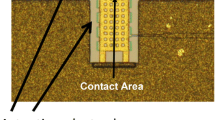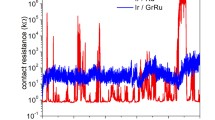Abstract
Electrical Contact Resistance (ECR) measurements are reported for RF micro-electromechanical switches with Au-RuO2 contacts, situated within an ultrahigh vacuum system equipped with in situ oxygen plasma cleaning capabilities. Two studies are reported, each involving a comparison of the ECR in vacuum and nitrogen environments for measurements performed immediately after cleaning. The first study reports measurements of initial resistance (resistance measured upon first time closure) versus pressure as dodecane gas is admitted to the chamber. A significant increase is observed at pressures in vacuum as low as 10−5 torr, (P/Psat < 10−4) consistent with earlier reports involving repetitive cycling of macroscopic switches in partial pressures of hydrocarbons in nitrogen. Somewhat unexpectedly, however, the resistance only doubles, even for pressures sufficiently high as to result in full monolayer condensation. In a second study, switch lifetimes in vacuum (10−8–10−9 torr) and nitrogen gas environments are compared, for switches operated immediately afterward, or alternatively left open for a number of days before operation. Although it was expected that vacuum would reduce and/or prevent contamination of the electrical contact surfaces, no enhancement or extension of lifetime was observed: Continuous operation of a switch in a nitrogen environment immediately after plasma cleaning was in fact the only procedure observed to indefinitely prolong device lifetime. The results suggest that (1) Hydrocarbon reaction products, but not mobile physisorbed hydrocarbons themselves, are responsible for increasing ECR by orders of magnitude and (2) Repetitive cycling motion of a clean switch in nitrogen inhibits formation of physisorbed hydrocarbon contaminants on the contacts, while vacuum levels far superior to 10−9 torr are required to prevent contamination.






Similar content being viewed by others
References
Rebeiz, G.M.: RF MEMS: Theory, Design, and Technology. Wiley, New Jersey (2003)
Yao, J.J.: RF MEMS from a device perspective. J. Micromech. Microeng. 10, R9–R38 (2000)
Patton, S.T., Eapen, K.C., Zabinski, J.S., Sanders, J.H., Voevodin, A.A.: J. Appl. Phys. 102, 024903 (2007)
Patton, S.T., Zabinski, J.S.: Fundamental studies of Au contacts in MEMS RF switches. Tribol. Lett. 18, 215–230 (2005)
Kogut, L., Komvolpoulos, K.: Electrical contact resistance theory for conductive rough surfaces separated by a thin insulating film. J. Appl. Phys. 95, 576–585 (2004)
Kogut, L., Komvopoulos, K.: Analytical current-voltage relationships for electron tunneling across rough interfaces. J. Appl. Phys. 97, 073701 (2005)
Dickrell, D.J., Dugger, M.T.: The effects of surface contamination on resistance degradation of hot-switched low-force MEMS electrical contacts. In: Electrical Contacts Proceedings of the Fifty-First IEEE Holm Conference, pp. 255–258 (2005)
Walker, M., Nordquist, C., Czaplewski, D., Patrizi, G., McGruer, N., Krim, J.: Impact of in situ oxygen plasma cleaning on the resistance of Ru and Au-Ru based rf microelectromechanical system contacts in vacuum. J. Appl. Phys. 107, 084509 (2010)
Persson, B.N.J.: Capillary adhesion between elastic solids with randomly rough surfaces. J. Phys. Condens. Matter 20, 315007 (2008)
Krim, J., Dash, J.G., Suzanne, J.: Triple-point wetting of light molecular gases on Au(111) surfaces. Phys. Rev. Lett. 52, 640–643 (1984)
Panella, V., Chiarello, R., Krim, J.: Adequacy of the Lifshitz theory for certain thin adsorbed films. Phys. Rev. Lett. 76, 3606–3609 (1996)
Mecke, K.R., Krim, J.: Adsorption isotherms and thermal fluctuations. Phys. Rev. B 53, 2073–2082 (1996)
Panella, V., Krim, J.: Adsorption isotherm study of the fractal scaling behavior of vapor-deposited silver films. Phys. Rev. E 49, 4179–4184 (1994)
Mak, C., Krim, J.: Quartz crystal microbalance studies of disorder-induced lubrication. Faraday Discuss. 107, 389–397 (1997)
Krim, J., Watts, E.T., Digel, J.: Slippage of simple liquid films adsorbed on silver and gold substrates. J. Vac. Sci. Technol. A 8(4), 3417–3420 (1990)
Chiarello, R.P., Krim, J., Thompson, C.: Quartz crystal microbalance and synchrotron X-ray reflectivity study of water and liquid xenon adsorbed on gold and quartz. Surf. Sci. 306, 359–366 (1994)
Ferguson, G.S., Chaudhury, M., Sigal, G.B., Whitesides, G.M.: Contact adhesion of thin gold films on elastomeric supports: cold welding under ambient conditions. Science 253, 776–778 (1991)
Brown, C., Morris, A.S., Kingon, A.I., et al.: Cryogenic performance of RF MEMS switch contacts. J. Microelectromech. Syst. 17, 1460 (2008)
Berman, D., Walker, M.J., Krim, J.: Contact voltage-induced softening of RF microelectromechanical system gold-on-gold contacts at cryogenic temperatures. J. Appl. Phys. 108, 044307 (2010)
Koidl, H.P., Rieder, W.F., Salzmann, Q.R.: Influence of physical/chemical characteristics of organic vapors and gas mixtures on their contact compatibility. IEEE Trans. Comp. Packag. Manufact. Technol. 22 (1999)
Koidl, H.P., Rieder, W.F., Salzmann, Q.R.: Influence of contact material parameters on contact compatibility of organic vapors. IEEE Trans. Comp. Packag. Manufact. Technol. 23 (2000)
Takahashi, K., Takahashi, Y., Hayashi, M., Sugawara, K., Imai, J., Mori, S.: Electrical contacts proceedings of the 43rd IEEE Holm conference on electrical contacts, pp. 340–348 (1997)
Weber, L., Lehr, M., Gmelin, E.: Investigation of the transport properties of gold point contacts. Phys. B 217, 181–192 (1996)
Borovsky, B., Krim, J., Syed Asif, S.A., Wahl, K.J.: Measuring nanomechanical properties of a dynamic contact using an indenter probe and quartz crystal microbalance. J. Appl. Phys. 90, 6391 (2001)
Greenwood, J.A., Williamson, J.B.P.: Contact of nominally flat surfaces. Proc. R. Soc. Lond. 295, 300–319 (1966)
Bowden, F.P., Tabor, D.: The area of contact between stationary and between moving surfaces. Proc. R. Soc. A 169, 391 (1939)
Bansal, D.G., Streater, J.L.: Voltage saturation in electrical contacts via viscoplastic creep. Acta Mater. 59, 726–737 (2011)
Rezvanian, O., Brown, C., Zikry, M.A., Kingon, A.I., Krim, J., Irving, D.L., Brenner, D.W.: The role of creep in the time dependent resistance of ohmic gold contacts in radio frequency microelectromechanical system devices. J. Appl. Phys. 104, 024513 (2008)
Brown, C., Rezvanian, O., Zikry, M.A., Krim, J.: Temperature dependence of asperity contact and contact resistance in gold RF MEMS switches. J. Micromech. Microeng. 19, 025006 (2009)
Rezvanian, O., Zikry, M.A., Brown, C., Krim, J.: Surface roughness, asperity contact and gold RF MEMS switch behavior. J. Micromech. Microeng. 17, 2006–2015 (2007)
Simmons, J.G.: Generalized formula for the electric tunnel effect between similar electrodes separated by a thin insulating film. J. Appl. Phys. 34, 1793 (1963)
Li, C., Thostenson, E.T., Chou, T.-W.: Dominant role of tunneling resistance in the electrical conductivity of carbon nanotube-based composites. App. Phys. Lett. 91, 223114 (2007)
Xu, S., Rezvanian, O., Peters, K., Zikry, M.A.: Tunneling effects and electrical conductivity of CNT polymer composites. In: MRS Proceedings, p. 1304 (2011)
Pitarke, J.M., Flores, F., Echenique, P.M.: Tunneling spectroscopy: surface geometry and interface potential effects. Surf. Sci. 234, 1–16 (1990)
Hong, Y.A., Hahn, J.R., Kang, H.: Electron transfer through interfacial water layer studied by scanning tunneling microscopy. J. Chem. Phys. 108, 4367 (1998)
Xu, B., Tao, N.J.: Measurement of single-molecule resistance by repeated formation of molecular junctions. Science 301, 1221 (2003)
Fortini, A., Mendelev, M.I., Buldyrev, S., Srolovitz, D.J.: Asperity contacts at the nanoscale: comparison of Ru and Au. J. Appl. Phys. 104, 074320 (2008)
Schwartz, P.V., Lavrich, D.J., Scoles, G.: Overlayers of long-chain organic molecules physisorbed on the surface of self-assembled monolayers of alkylthiols on Au(111). Langmuir 19, 4969 (2003)
Iwasaki, Y., Izumi, A., Tsurumaki, H., Namki, A., Oizumi, H., Nishiyama, I.: Oxidation and reduction of thin Ru films by gas plasma. Appl. Surf. Sci. 253, 8699 (2007)
Nishiyama, I., Oizumi, H., Motai, K.: Reduction of oxide layer on Ru surface by atomic hydrogen treatment. J. Vac. Sci. Technol. B 23, 3129 (2005)
Abe, Y., Kaga, Y., Kawamura, M., Sasaki, K.: Effects of O2 gas flow ratio and flow rate on the formation of RuO2 thin films by reactive sputtering. J. Vac. Sci. Technol. B 18, 1328 (2000)
Brown, C., Morris, A.S., Kingon, A.I., Krim, J.: Cryogenic performance of RF MEMS switch contacts. J. Microeletromech. Syst. 17, 1460 (2008)
Konchits, V.V., Kim, C.K.: Electric current passage and interface heating. Wear 232 (1999)
Sauerbrey, G.: Zeitschrift fur Physik 155(2), 206–222 (1959)
Hook, D.A., Miller, B.P., Vlastakis, B., Dugger, M.T., Krim, J.: Vapor phase lubrication at ultra-low partial pressures of ethanol (submitted)
Bouju, X., Girard, Ch., Tang, H., Joachin, C., Pizzagalli, L.: van der Waals atomic trap in a scanning-tunneling-microscope junction: tip shape, dynamical effects, and tunnel current signatures. Phys. Rev. B 55, 16498 (1997)
Kurpick, U., Rahman, T.S.: Tip induced motion of adatoms on metal surfaces. Phys. Rev. Lett. 83, 2765 (1999)
Jang, Y.H., Barber, J.R.: Effect of contact statistics on electrical contact resistance. J. Appl. Phys. 94, 7215 (2003)
Lorenz, C.D., Chandross, M., Grest, G.S.: Large scale molecular dynamics simulations of vapor phase lubrication for MEMS. J. Adhesion Sci. Technol. 24, 2453 (2010)
Abdelmaksoud, M., Lee, S.M., Padgett, C.W., Irving, D.W., Brenner, D.W., Krim, J.: STM, QCM, and the windshield wiper effect: a joint theoretical-experimental study of adsorbate mobility and lubrication at high sliding rates. Langmuir 22, 9606–9609 (2006)
Brenner, D.W., Irving, D.L., Kingon, A.I., Krim, J.: Multiscale analysis of liquid lubrication trends from industrial machines to micro-electrical-mechanical systems. Langmuir 23, 9253–9257 (2007)
Berman, D., Walker, M.J., Nordquist, C.D., Krim, J.: Impact of adsorbed organic monolayers on vacuum electron tunneling contributions to electrical resistance at an asperity contact (In preparation)
Acknowledgments
This study has been supported by NSF DMR0805204, the Extreme Friction MURI program, AFOSR # FA9550-04-1-0381, and the DARPA S&T Fundamentals Program, ‘Center for RF MEMS Reliability and Design Fundamentals,’ grant no HR0011-06-1-0051. Sandia National Laboratories is a multi program laboratory managed and operated by Sandia Corporation, a wholly owned subsidiary of Lockheed Martin Corporation, for the U.S. Department of Energy’s National Nuclear Security Administration under contract DE-AC04-94AL85000. The authors acknowledge G. A. Patrizi, F. A. Austin, and Sandia MESAfab operations for switch fabrication. Useful discussions with D. Dougherty, K. Komvopoulos, M. Zikry, D. A. Czaplewski, W. D. Cowan, and C.W. Dyck are greatly appreciated.
Author information
Authors and Affiliations
Corresponding author
Rights and permissions
About this article
Cite this article
Walker, M.J., Berman, D., Nordquist, C. et al. Electrical Contact Resistance and Device Lifetime Measurements of Au-RuO2-Based RF MEMS Exposed to Hydrocarbons in Vacuum and Nitrogen Environments. Tribol Lett 44, 305 (2011). https://doi.org/10.1007/s11249-011-9849-8
Received:
Accepted:
Published:
DOI: https://doi.org/10.1007/s11249-011-9849-8




